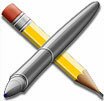 |
One of Those Nice Things To Know |
 |
 I was doing my regular weekly clone of my hard disk to a firewire drive. I went to test the backup and my mind went blank on the keystroke (you would think I would remember option, but that is for another article). After a quick Google search, I located the item. Then I got to thinking. What if my hard disk really crashed and I couldn't make it to the net. Maybe my machine wouldn't boot and I would have to boot into safe mode or single user mode. I was doing my regular weekly clone of my hard disk to a firewire drive. I went to test the backup and my mind went blank on the keystroke (you would think I would remember option, but that is for another article). After a quick Google search, I located the item. Then I got to thinking. What if my hard disk really crashed and I couldn't make it to the net. Maybe my machine wouldn't boot and I would have to boot into safe mode or single user mode.
There are many keystroke commands that can be given to Mac OS X to alter the boot behavior for troubleshooting or testing. It is a good idea to have a quick reference card of the keystrokes laying around in case you need them. An emergency is not the time to try and remember these things.
Like every other emergency procedure, it is a good idea to try these things out so that you get the feel for how they work and so that there are no surprises when you need to use them.
Here is a short list of the keystrokes I use most often:
Command-s : Boot into Single-User mode. Very convenient for running a file system check on your hard disk (fsck -fy)
option : displays a list of bootable volumes attached to your machine and allows you to choose which one you want to boot from.
x : Forces you to boot into OS X
option-command-shift-delete : Bypasses the normal startup volume and looks for alternate startup volumes attached to your system.
c : boot from a CD that has a system folder (such as the OS X install disk that came with your machine).
n : boot from the network
r : forces powerbook screen test
t : start machine in firewire target disk mode.
shift : boot in Safe mode. This temporarily disables login items and non-essential kernel extension files. Very good for troubleshooting nasty driver related issues.
option-command-p-r : reset the PRAM
mouse-left shift : (To be done after blue progress bar appears) Display user login screen (if you PC is set up to boot into a specific user at login). Useful for quickly checking preference problems by logging in as a test user.
option-command-o-f boot into Open Firmware mode. Please read the details in the Apple support docs - http://www.apple.com/support/
Another good thing to know are what the various chimes at startup mean. The startup diagnostics of your machine will output different chimes to indicate different problems.
Breaking Glass - This usually occurs when there is a hardware problem.
4 Beeps - Boot into safe mode. If the problem goes away, then you have a problem with drivers or startup items.
8 beeps - usually indicates bad RAM.
It is a good idea to keep a notebook with problems and solutions that you encounter. Pretty soon, you have a pretty good 'black book' for troubleshooting and you don't need an internet connection to get the information. |
|
March 4 2005, 11:57 AM EDT, by |
Comments:
|
| matty |
3/4/05, 8:21 PM EDT |
"It is a good idea to keep a notebook with problems and solutions that you encounter. Pretty soon, you have a pretty good 'black book' for troubleshooting and you don't need an internet connection to get the information."
lol. This is the only information left on my old thinkpad, the one I used in the dark age of computing before I discovered the beauty of the iBook.
|
This article is archived, so you may not comment on it.
(The good news is there's always the shoutbox, the
forums or the
contact form if you're socially-inclined at the moment!)

